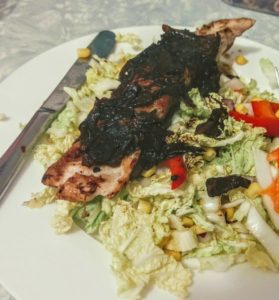The man in the bar was raving about skeletons. Or maybe demons? He wasn’t exactly very lucid.
It was enough to get Augustus’ attention. He stood up — six feet of armoured muscle — and told the taproom in no uncertain terms that folk had to stop the undead.
That shut the man up.
In fact, half the bar fell silent. It looked like Augustus and Patricia would be working alone again.
First order of business: find out where this infestation was. Patricia made a circuit of the bar, while Augustus stayed at the table hoping for volunteers (and drinking).
He found three, each with information. Melil — a forest ranger in thick hide — had heard tales of cows and other creatures drained of blood. A cloaked figure named Micala reported scattered incidents of arson and vandalism, probably the work of goblins.
And rumor spoke of a macabre skeleton procession in a valley to the north.
As the four adventurers began their plans, an aged crone shuffled up to the table. She introduced herself as Liz, and opined that the party seemed in need of a healer.
There was definitely something off about Liz, but the party were happy to accept her offer. The group agreed to start at dawn, and with the drinking done (and money borrowed for Augustus’ bar tab), they turned in for the night.
The next day, three townsfolk were waiting for them outside the inn. There was a somewhat scrawny soldier called Frederik; a gentlewoman, Erassi … and Tarramor, who soon proved himself a bigger idiot than he looked.
After a brief visit to the temple for Erastil’s blessing (which took the form of holy water), Augustus led the group into the forest.
A few hundred yards in, he was thoroughly lost.
Melil took over and led the party back in the right direction. Following some discussion, the group agreed she would lead them around to approach the valley with the sun behind them.
“Humies!”
A goblin squealed somewhere in the trees ahead.
The party lined up to face the foe, villagers behind the experienced adventurers.
The first goblin was equally cautious, shooting wildly from cover. The second charged, and was quickly dispatched by Augustus.
The third advanced more slowly, into the crack of Micala’s spiked whip — then was pulled down by their dog, Flair.
Tarramorr took the opportunity to pose atop the body. The third goblin charged him with a scream of rage.
Frederik chased after it. So did Augustus, who swung his sword in blow that would sever any man’s head from his shoulders.
It sailed right over the four-foot goblin, and stopped just an inch short of Frederik’s neck.
Then Melil stepped up and disbatched the goblin with a simple stab.
When the dust settled, Tarramorr was the only person injured — though Frederik was understandably still in shock.
